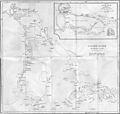Broadway expedition facts for kids
Quick facts for kids Broadway expedition |
|||||||
|---|---|---|---|---|---|---|---|
| Part of the First Opium War | |||||||
 The steamer Nemesis engaging the Houchung fort and Chinese war junks, 13 March 1841 |
|||||||
|
|||||||
| Belligerents | |||||||
| Commanders and leaders | |||||||
| James Scott | Unknown | ||||||
| Strength | |||||||
| 2 steamers 1 corvette 3 other ships |
15 junks 6 forts |
||||||
| Casualties and losses | |||||||
| 3 wounded | 9 junks destroyed 6 forts captured 105 guns captured |
||||||
The Broadway expedition was a British military trip during the First Opium War. It happened from March 13 to 15, 1841, in China. The goal was to explore the Broadway River, now known as the Xi River, in Guangdong province.
This river was also called the Inner Passage or Macao Passage. It was a tricky waterway connecting the Portuguese area of Macao to the Chinese city of Canton. People in China believed this river was too shallow and complicated for foreign ships.
The British ship Nemesis was an iron steamship. It was special because it had a very shallow draught (how deep the ship sits in the water). This allowed it to travel through parts of the river that were only about 5 or 6 feet deep. This was a big advantage for the expedition.
Contents
The Expedition Begins
The expedition started on the morning of March 13 in Macao. Captain James Scott led the British fleet. This group of ships included HMS Samarang and two steamships from the East India Company, the Nemesis and the Atlanta.
Three smaller boats also joined the Nemesis. Two came from the Samarang and one from the Atlanta. On board the Nemesis, led by Captain William Hall, were important British officials.
These officials included Charles Elliot, who was in charge of British trade. Alexander Johnston was his assistant. Two interpreters, John Morrison and Robert Thom, were also on board. Their knowledge of the Chinese language helped the expedition a lot.
Capturing Forts and Ships
The British fleet moved up the river, capturing several forts along the way. These forts had cannons that defended the waterway. The expedition also fought against Chinese war junks, which were traditional Chinese sailing ships.
Forts Captured on March 13
On the first day, March 13, the British captured several forts:
- Motow: This fort had 13 cannons.
- Tei-yat-kok: This fort had 12 to 14 cannons.
- Houchung: This fort had 14 to 15 cannons. It was defended by nine war junks. Seven of these junks were destroyed, and two managed to escape. The British captured 28 cannons here.
- Fie-shu-kok: This fort had 7 cannons.
After these battles, the fleet reached the town of Heangshan, which is now called Zhongshan. The Nemesis chased the two junks that had escaped earlier. Several Chinese official boats, called mandarin boats, followed them. One of the junks was captured, and it had four cannons.
- Sheongchap: This fort had 8 cannons.
Forts Captured on March 14 and 15
The expedition continued its mission over the next two days.
- On March 14, they captured the Kong-how (or Hong-how) fort, which had 9 cannons.
- On March 15, they captured one war junk that had 7 cannons.
During the expedition, the British had only 3 people wounded. They destroyed 9 Chinese junks and captured 6 forts. In total, they took 105 cannons from the Chinese forces. The Broadway expedition ended in a British victory.
Images for kids



